Do you like guacamole? You might be curious to find out what goes into this delicious dip and its unique flavor.
In this article, you’ll learn everything you need to know about guacamole — from what makes it special to how it tastes.
What is Guacamole?

Guacamole is a traditional Mexican dip made from ripe, mashed avocados, onions, tomatoes and cilantro, along with some lime or lemon juice to balance the flavor.
The textures of guacamole vary from creamy to chunky.
It’s often served as an accompaniment to nachos or tacos, but can also be used as a topping for beef or chicken enchiladas and burritos.
Guacamole can be served cold or at room temperature.
Despite its appearance, guacamole is more than just a savory dip – it’s packed full of vitamins and minerals too; avocados are high in healthy fats (monounsaturated fatty acids) that contain essential vitamins like A and E, plus minerals like copper and magnesium.
Avocados are also great sources of fibre, both insoluble fibres which help digestion and soluble fibres which can help lower your cholesterol levels.
Guacamole is also low in cholesterol and sodium compared to other dips and sauces.
Guacamole can come in many different flavors depending on the ingredients you use – although most people think of a tangy flavor because of the lime juice added to it – so don’t let anyone limit your imagination when making this tasty treat.
The perfect guacamole recipe is up to you; experiment with different vegetables or spices until you find the combination that best suits your palette and enjoy.
What Does Guacamole Taste Like?
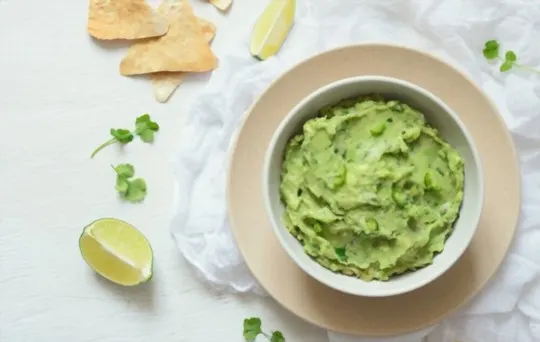
Guacamole is a traditional Mexican dip made primarily from mashed avocados, diced onions, tomatoes, cilantro, and lime juice.
When blended together, these ingredients create a creamy, exotic dip with a unique flavor that is beloved by many.
The main ingredient in guacamole is the avocado.
Avocados have a bright flavor with notes of both grassiness and nuttiness.
Combined with the sharpness of diced onions, tangy tomatoes, citrus-y lime juice, and earthy cilantro leaves creates an entirely new flavor profile.
The texture of guacamole ranges from smooth to chunky depending on the desired consistency.
It can be scooped up just like any other dip—with your favorite chips or vegetables—or slathered on sandwiches or tacos as a condiment.
Guacamole can also take on different levels of spice depending on what ingredients are added such as jalapeños or pepper flakes for heat or roasted garlic for extra flavor dimension.
It provides an interesting blend of flavors that make it suitable to use as either an appetizer or entree accompaniment.
Not only does guacamole’s unique flavor combination make it incredibly delicious but it also has the added bonus of being healthy too.
Avocados are high in healthy monounsaturated fatty acids and contain vitamin C and E as well as dietary fiber making them an excellent addition to any meal plan.
So why not experiment with this classic favorite by adding something unexpected—such as peaches, passionfruit or mango—to give it more depth and intrigue? Enjoy.
Ingredients that Affect the Taste of Guacamole
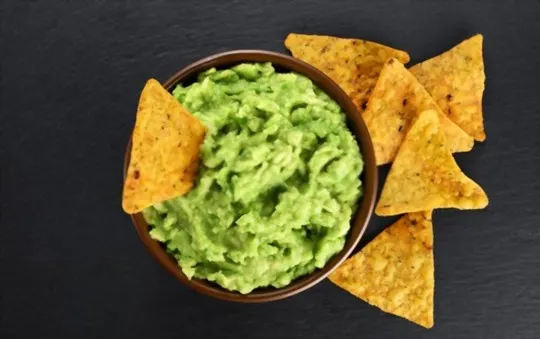
Making great tasting guacamole isn’t just about throwing all the ingredients in a bowl and stirring – there are several factors that influence the flavor of your end product.
The main ingredients you will need for the perfect guacamole and the taste they provide are provided below.
- Avocado – The ripeness of your avocados will determine how creamy your guacamole is. Too ripe or over-ripe avocados can make for a gluey guacamole, so use them at their prime.
- Lemons or Limes – This one is all about balance. If you add enough juice from either citrus, it will brighten up your dish and cut through the richness of other flavors. However, if you add too much acidity it can overpower everything else in the dish, so use sparingly.
- Onions – These may vary depending on personal preference but most guacamole recipes feature red onions as they are less sweet than white onions and mellow in flavor when cooked. As with citrus, too much onion can ruin an otherwise delicious dip.
- Garlic – Much like onion, garlic adds complexity to a dish but too much will make it difficult to enjoy any other part of the dip. Use fresh garlic as opposed to jarred varieties as this adds more zing without containing any preservatives which could overpower flavors already present in your dish.
- Tomatoes – Tomatoes tend to make great additions to guacamole because they help improve texture and flavor combinations with their juicy sweetness tangy bite when used correctly – always use fresh tomatoes for best results. Additionally, tomatoes offer a slight crunch that pairs well with creamy avocado-based dips like guacamole or salsa Lizano non-heated Mexican style hot sauces such as Salsa Valentina offer pickled vinegar-based added flavours that work well as ‘seconderos’ (second tier ingredients). Peppers from milder poblanos to hotter jalapeños also bring an array of heat levels while adding crunchiness when mixed into prepared dishes like enchiladas or chilaquiles right ahead before serving them.
1 – Avocado
Avocado, often referred to as an alligator pear due to its bumpy skin, is the star of the guacamole show.
The creamy texture and mild flavor of the avocado provide a rich backdrop for the other ingredients that are used in guacamole recipes.
Avocados are an excellent source of healthy fats, vitamins, and minerals such as potassium and lutein, making them a nutritious addition to your diet.
Avocados can vary in size and color based on their variety – most commonly found are Haas avocados – and depending on how ripe they are.
A fully ripe avocado will be soft to the touch while an unripe one will be rock hard.
If you cut into a ripe avocado, it should reveal a creamy yellow-green flesh that is not discolored or “off” in any way; if it is browning or discolored in any way then it has gone bad and should be discarded.
2 – Lime Juice
Lime juice is a key flavor element in most traditional guacamole recipes and contributes a tart, acidic element that helps to balance the creaminess of the avocados.
If you’re looking for a brighter guacamole, add extra lime juice to your ingredients list.
The juice from one lime can usually be enough for about two-and-a-half to three cups of guacamole, so you may want to consider adding more lime juice if you’re making a larger batch.
Keep in mind that some store bought limes have thicker skins and less juice, so it’s important to taste test your guacamole before serving it.
3 – Salt
Salt is a key ingredient in helping to bring out the flavor in guacamole.
Not only does it help to bring out the flavors of the other ingredients, it helps to balance out any bitterness, enhances sweetness, and adds a savory note.
Without salt, guacamole can be bland and have an unappealing texture.
When adding salt to guacamole, start with small amounts then add more later until you get the desired level of taste.
Remember that if you are adding salsa or an acidic ingredient like lime juice, then you will want to adjust the amount of salt accordingly.
Reducing or eliminating these ingredients can help to reduce the need for salt when making guacamole.
4 – Other Ingredients
Other ingredients can also be used to enhance the flavors and textures of guacamole.
Depending on the recipe, they can add either a boost of flavor, or a nice crunchy texture.
Commonly used ingredients are:
- Lime juice: Lime juice adds bright citrus and acidic flavors to counteract the richness of avocados. It’s usually added in combination with other ingredients like onions, jalapenos or garlic to create an enjoyable balance of flavors.
- Red onions: These are finely chopped red onions that can be used as an alternative to chives or onions for a stronger onion flavor. They provide a sweet and juicy element to guacamole which give it some added texture and dimension.
- Tomatoes: Diced tomatoes have time tested traditional uses for guacamole recipes. The tomato contributes a unique sweetness that makes guacamoles great for dipping salsa chips in or spreading on sandwiches or wraps.
- Jalapenos: Jalapenos give guacamole some extra kick as well as added spiciness that most people enjoy in their dishes. You can adjust the spiciness intensity by removing its seeds before chopping it up and adding it into your recipe mix − just make sure you wash your hands after handling them.
- Garlic: Garlic brings out more intense flavors in food items and is often combined with other ingredients such as cilantro, jalapeno, tomatoes, and onions when making guacamole in order to further enhance their combined flavor profile.
- Cilantro: Cilantro is one of the most popular herbs used with Mexican food due its distinct flavor profile − giving it a freshness that improves many dishes including guacamoles when finely diced into small pieces and mixed into the dish.
How to Make Guacamole to Enhance its Flavor
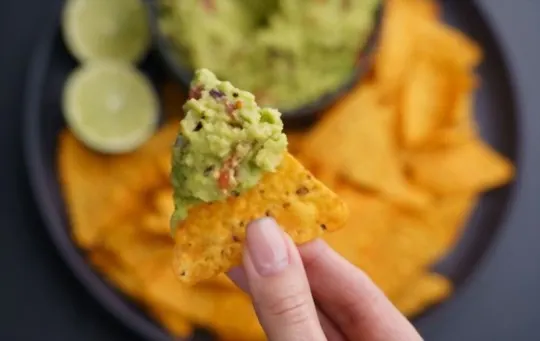
Making your own guacamole is the best way to maximize its flavor.
Guacamole is a delicious and nutritious snack that can easily be made at home with a few simple ingredients.
To make it, you’ll need avocados, lime juice, cilantro, garlic and red onion.
To begin, chop up the avocados into small cubes and mash them in a bowl with a fork or potato masher until you have achieved the desired consistency–it will depend on whether you prefer your guacamole smooth or chunky.
Add salt and pepper to taste or any other herbs or spices if you want an extra kick.
Next, add diced red onion and chopped cilantro to your mashed avocado mixture before stirring in some freshly-squeezed lime juice to bring out the flavors of these ingredients.
Finally, mince garlic cloves into small pieces and mix them in with the other ingredients until everything is well-combined.
Your homemade guacamole should have a flavorful balance of creamy texture from the avocado combined with vibrant tones from the vegetables and punchy acidity from the lime juice.
It’s best served immediately but can keep for up to two days if stored properly in an airtight container in the refrigerator.
Enjoy your guacamole on it’s own or as an accompaniment to tacos or fajitas.
Nutritional Value and Health Benefits of Guacamole
In addition to its flavor and versatility, guacamole is packed with vitamins, minerals and other nutrients that provide many health benefits.
For example, avocados are rich in healthy monounsaturated fats which can help lower cholesterol levels and protect against heart disease.
Guacamole is also a good source of potassium, vitamin K, vitamin C and fiber.
If you are vegan or vegetarian, guacamole can be used as an alternative source of protein in your diet.
Studies have shown that consuming monounsaturated fat such as avocados can lead to a decreased risk of several types of cancers.
Additionally, the high levels of polyphenols found in guacamole can help protect against oxidative stress caused by environmental toxins.
Guacamole also includes several ingredients that have anti-inflammatory properties.
Onions contain flavonoids that may help reduce inflammation caused by asthma and arthritis while garlic contains polysulfides that give it antiviral properties as well as antifungal properties.
Chili peppers are rich in capsaicin which has been shown to alleviate inflammation and speed up healing of wounds.
In addition to its other health benefits, guacamole may help with weight management since it contains less fat than most other dips like hummus or cheese dip.
Serving Suggestions and Pairings for Guacamole
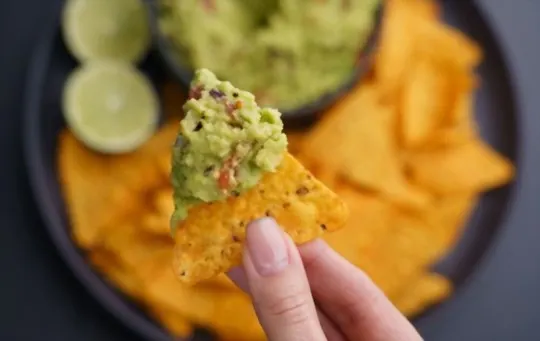
Guacamole is a condiment and dip that can be enjoyed in many different ways.
It is often used as a topping or side dish, but can also stand on its own as an appetizer or dip.
It pairs particularly well with salty and crunchy snacks such as tortilla chips, but there are many creative ways to serve guacamole for any occasion.
There are various ways to prepare guacamole to enhance its flavor profile or the overall experience of eating it.
You can mix in ingredients like diced tomatoes, red onion, cilantro, jalapeno peppers, or lime juice for added flavor.
You can also customize the texture by mashing it with a fork or pureeing it in a food processor.
Adding some sour cream makes for an extra creamy guacamole that you may find even more enjoyable.
When thinking of what to pair with guacamole, there are endless possibilities that accommodate all kinds of diets and flavors.
With its subtle sweetness and creamy texture, guacamole is most often served with salty accompaniments like fried plantains, chips of all kinds (tortilla chips being one of the most popular) and crudités such as carrots and celery sticks.
Spicy dishes made with sausage or ground turkey often pair nicely as well.
For those looking for something on the sweeter side to complement their avocado dip, try pairing it with tropical fruits like mangoes or pineapple chunks –– the sweet-tart flavor will make for an unforgettable combination.
Lastly – why not try guacamole desserts? Avocado ice cream is one example -– you may want to give it a try.
No matter how you serve your guacamole, it’s sure to be a tasty treat.
Conclusion
In conclusion, guacamole is a delicious dip, spread, and topping that pairs well with so many foods.
It has a distinct and irresistible flavor that appeals to many palates.
The unique combination of creamy avocados, zesty cilantro and lime juice, fresh tomatoes and onions, subtly spicy jalapeños, and crunchy garlic creates a vibrant and flavorful mixture that is perfect for scooping with chips or adding as an accent layer in tacos.
Guacamole is a simple condiment made from just a few ingredients but brings big taste to any plate.
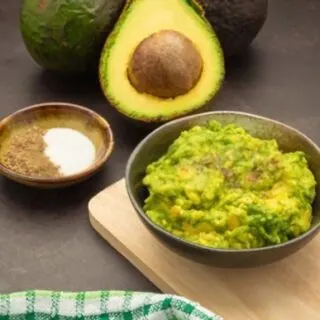
What Does Guacamole Taste Like? A Comprehensive Guide
Ingredients
- Guacamole
- Ingredients from your selected recipes
Instructions
- Select your favorite ingredient from the range available in this article.
- Collect all the necessary items to make the recipe.
- Use the instructions provided to prepare a delicious dish in 30 minutes or less.

Carrie is a food writer and editor with more than 15 years of experience. She has worked for some of the biggest names in the food industry, including Bon Appétit, Food & Wine, and Martha Stewart Living.
As the Editor in Chief of IntroChicago.com, Carrie oversees all of the content on the site. She also manages the team of contributing writers and editors, who help to create delicious recipes, helpful tips, and informative articles that you’ll find on the site.
A native of the Chicago area, Carrie is passionate about all things food. She loves trying new restaurants and experimenting with new recipes in her kitchen. She’s also a graduate of the Culinary Institute of America, so she knows a thing or two about food!
